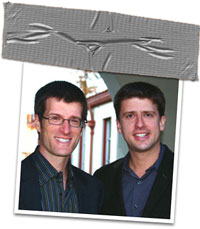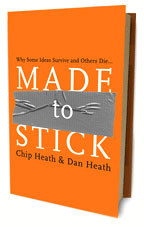Quick, what’s the last political campaign slogan you remember? Is it the Democrats’ recent zinger, “Together, we can do better”? Probably not. You probably forgot that one before they got to “better.”

Chip Heath and Dan Heath.
Photo: Amy Surdacki
In an age of instant media, ubiquitous advertising, and partisan politics, everyone wants to grab the public eye. There are thousands of demands on public attention. What kind of message gets through and gets remembered? What makes some ideas “stick” and others slip away?
Dan and Chip Heath ponder sticky messages professionally — Dan does corporate training, Chip’s a professor of organizational behavior at Stanford — and they’ve come up with a simple way to identify and craft them. It’s described in their new book Made to Stick: Why Some Ideas Survive and Others Die.
Environmentalists are notoriously self-critical about their failure to effectively communicate on, among other things, the subject of global warming. When I heard Chip was coming through town, I figured I’d elicit some free consulting in the guise of an interview.
You talk in your book about the “curse of knowledge.” Can you explain that?
The curse of knowledge basically says that the downside of expertise is it becomes really hard to mentally simulate what it’s like not to know. If you ever talk to the IT person at your organization about what’s wrong with your computer — that’s the curse of knowledge. That person is telling you what they know, but they’re talking in such complex and abstract terms that you don’t get it. The problem is, they can’t fathom how ignorant the rest of us are about computers.
All of us are kind of like that IT person in domains we care about. So if you’re passionate about the environment, you have spent years understanding the nuances and the implications and the theories and applications. If you’re trying to get your message across to somebody who doesn’t have that background, you’ve got to overcome that curse of knowledge.
That’s a really difficult task. It’s what keeps there from being more brilliant messages. There are lots of people with brilliant ideas, but there are many fewer brilliant messages than brilliant ideas.
How do you overcome it?
One of the examples we talk about in the book is The Nature Conservancy. They have this problem. California is this amazing resource for diversity, because you’ve got broad north-south distance and something that goes from the oceans to the mountains, so you get all these microclimates with their unique flora and fauna. The Nature Conservancy colored in this map of California and realized that 40 percent of it met their criteria for important biodiversity, and 9 percent of that was in critical danger.

Made to Stick, by Chip Heath and Dan Heath.
Now, talk about demoralizing. Historically, the way they made their name was by buying land and taking it off the market — this bucks-an-acre strategy. It’s concrete, it’s easy for people to understand, it’s easy to talk about to your employees, it’s easy to talk about to donors. Now that strategy’s gone out the window, because you can’t do bucks-an-acre for 40 percent of the state of California. There’s just not enough money.
So they’re going to have to get involved in affecting policy. They’re going to have to get involved in being a broker that could get information to other groups. But they were spinning with how to talk about this complex issue. The first reaction is to break that goal down. You do this for 20 years, so that’s 2 percent of the state per year. Well, that’s not helping. Maybe translate that into acres. Well, two percent is 2 million acres. That’s a step more concrete … but nobody can picture 2 million acres.
What they finally started doing is talking about landscapes. They would take a blob on the map and give it a name; they would start talking to people, for example, about the “Mount Hamilton Wilderness.” It’s an area around Silicon Valley — it’s got round hills, some oak trees. It’s called oak savanna. It’s not very exciting, like the redwoods. But it turns out it’s the largest intact area of land in Northern California outside of Yosemite, and it’s being systematically chopped up by urban sprawl from Silicon Valley. It also acts as the watershed for the Bay Area.
It turns out, once they started talking about the Mount Hamilton Wilderness, local environmental groups started writing that into their plans and their lobbying. The Packard Foundation, which is located in Silicon Valley, gave a donation to save the Mount Hamilton Wilderness.
They made up the name “Mount Hamilton Wilderness”?
Mount Hamilton is a peak in the area, and it has a famous observatory, but yeah. They’re essentially coming up with names and identities for these abstract things. That’s a brilliant solution to a set of complex issues.
How should environmentalists talk about global warming? It’s got very few hooks.
I don’t know enough about the science in that area, but if you look at the national discussion of climate change, it did change after the paper was published in Nature about hurricanes. That was close in proximity to the New Orleans hurricane. All the sudden there was a way for people to map [climate change] in a concrete way. That’s the kind of thing you’re looking for — the concrete, sensory image that is truthful to the science but is going to capture attention.
Here’s a mistake people have made for years in talking about global warming. Scientists know the statistical significance of seven-tenths of a degree. But 0.7 degrees — if it does mean anything to people, it’s kind of trivial. I mean, I live in California, and the temperature in the morning starts in the 40s, and by the middle of the day it’s 70 degrees. What’s 0.7 degrees in a 30-degree swing in one day?
But I had a student in my class from the Woods Institute [for the Environment] at Stanford. She wrote this brilliant paper where she said, you know what 1 degree means? One degree means that this kind of bird species in Arkansas on average is going to have 10 fewer days to breed; the whole breeding season is 35 days. Or 1 degree over time translates into a 100-mile northern shift in the birch forests in New England.
Do you feel like you’ve gotten good at messaging? Is it a skill?
It’s actually a skill. I feel like I’ve gotten better at it.
But the biggest advantage is, I walk into workshops — we do a lot of workshops at the Stanford Center for Social Innovation, bringing together nonprofit groups in the arts, humanities, and social science — and ask these organizations, “OK, tell me why as a donor I should give to your organization.” And people are extraordinarily inarticulate about this stuff!
The biggest impact we make on these organizations is just by being dumb outsiders — by forcing them to keep saying something, to keep asking the question, until they come out with something concrete. They always have it. They have the knowledge about how to articulate a compelling case buried somewhere inside the organization. It’s just a question of holding up all the things you know and putting them against this checklist and saying, oh, it’s not concrete enough, or, do we have a story to talk about this?
I love the Bill McDonough story about the Rohner Textile factory. Because of the chemicals used in the dying operations, the Swiss government had declared the trimmings from the fabric hazardous waste. By the end of that story, he’s turned around that plant so it’s a water purification plant. That’s a story we don’t have enough of — organizations aren’t trying to pick the successes we do have and talk about them.
There’s a danger whenever you get a big, scary issue. Say you’re a smoker and I tell you about lung cancer. There are two things you can do. You can change — but it turns out empirically the other, more common pattern of behavior is you tune me out. The commercial shows you blackened lungs — well, you can either change your behavior or stop listening to those commercials. We’re in danger in the environmental area because the awareness battle has been won, but what’s still up in the air is whether people think there is anything we can do about the problem. You want to be giving people a sense of empowerment.
When you talk to someone about smoking, they can not smoke, and that solves the problem of them smoking. But for global warming, you have to convince everybody to do these things for 50 to 100 years — not to solve the problem, but to reduce the effects to tolerable levels for a generation or two down the line. That’s not a riveting message.
That’s a message you’re never going to get across. If you’re going to inspire people to change, there has to be some sense that they’re part of something bigger, that they’re going to make a meaningful difference. One of the flaws in our reasoning is we get more motivated to help a single 7-year-old girl in Africa who’s hungry than we do to help 21 million people who are dying of starvation. When the problem becomes too big or too intangible, our minds just shut down.
There is no 7-year-old girl to help on climate change.
There is. There is Rohner Textile. There’s The Nature Conservancy’s Mount Hamilton Wilderness. There’s the [World Wildlife Fund’s mascot] panda — that panda’s done a lot of good.
When people talk about climate change, there are stories in their minds. Scientists know the stories. When ice sheets melt, what animals does that disenfranchise? What does that do to the landscape? Unpacking those implicit mental images is something Al Gore did well in his movie, and that most conversations about climate change absolutely don’t. Yeah, it’s misleading to say that global warming caused Hurricane Katrina, but it is entirely valid to say that you’re increasing the probability of events like Hurricane Katrina because of climate change. It’s just like any probabilistic argument — if you don’t wear a seatbelt, you’re more likely to die.

